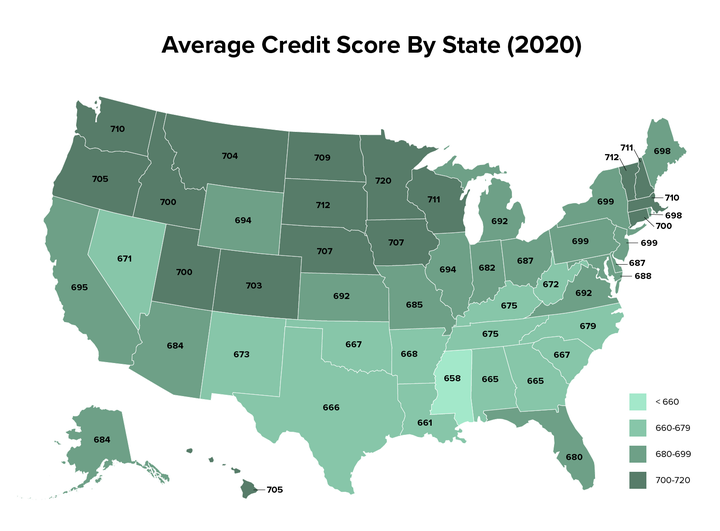In terms of our wallets, the year 2020 was off to a pretty great start. Unemployment numbers were down, the stock market was steadily ticking upward and things looked bright. Then the coronavirus pandemic hit, wreaking financial devastation on businesses and consumers alike. But one thing that hasn’t suffered ― at least not yet ― is people’s credit scores.
As part of its 11th annual State of Credit report, credit bureau Experian examined how consumers are managing their credit amid the COVID-19 pandemic, including how credit scores break down for each U.S. state.
2020 Average Credit Score Rankings
As part of the annual study, Experian compared VantageScores by state and ranked them by their average score as of the second quarter of 2020, which ended June 30. The top five states were Minnesota, South Dakota, Vermont, New Hampshire and Wisconsin, with average credit scores of 711 or higher. Mississippi, Louisiana, Georgia, Alabama and Texas took the five lowest spots, with average scores below 666. Notably, scores in both the top and bottom rankings are higher overall than last year.

Clearly, there are geographical trends as to which parts of the country have the highest and lowest scores. But pinpointing the reasons isn’t a simple task. “This is a trend we’ve seen consistently,” said Rod Griffin, senior director of consumer education and advocacy for Experian. He noted that states with the highest average credit scores tend to have lower credit utilization and fewer missed payments, while states with lower scores have higher utilization and missed payment rates.
Aside from credit utilization, Griffin noted in past rankings that there are several other factors that can influence scores, including education levels, job markets, cultural approaches to using credit and more.
“The State of Credit survey helps us to identify trends, but doesn’t enable us to pinpoint specific causes for those trends,” he said.
The report also found that nationally, the average credit score is up by 6 points year over year, to 688. The average person carries three credit cards, while average credit card balances decreased by $732 compared to last year, to $5,897.
How Are Average Credit Scores Increasing?
Perhaps the most surprising finding from the report is that average credit scores have actually increased over the last year, despite financial troubles caused by the pandemic.
“While the pandemic has created serious financial challenges for many, we’re seeing promising signs in terms of how consumers are managing their credit histories,” Griffin said. In fact, Experian has seen a trend of slowly but steadily increasing credit scores over the last decade. “Unlike the onset of the recession in 2008, when people were overleveraged and the economy was declining, people were generally in a stronger financial situation when the COVID-19 response forced the economy to a standstill.”
Griffin noted that government assistance programs also appeared to help people further reduce credit card balances and maintain payments on other debts, putting some people in a better position to weather this chaotic situation.
However, it may be that credit scores are a lagging indicator. It’s likely that the financial repercussions of the pandemic haven’t been fully realized. We may see that in 2021, the upward trend reverses if government assistance and stimulus programs run dry and more Americans rely on debt to survive.
“I’m hopeful that we’ll continue to see positive outcomes as the nation emerges from the pandemic, but it is still difficult to predict what the future will bring in these unique, uncertain times,” Griffin said. “While it’s hard to know what the financial picture will look like, educating people about the information included in their credit report, how to maintain that information and ways they can improve their credit histories is key to protecting financial health in 2021 and beyond.”
Keep Your Credit In Check
Though the trends highlighted in the State of Credit report are certainly interesting, Griffin emphasized that the most important takeaway is that good credit is key to our financial lives.
The most important thing you can do to protect your credit, according to Griffin, is to be proactive. You can start by requesting free copies of your credit reports through AnnualCreditReport.com, which will give you an idea of where you stand. You can also review your reports for errors and dispute any inaccurate information, which will give your score an instant boost.
If possible, continue to make your bill payments on time. “Late payments are the most damaging items in your credit history and will drag down your credit scores and slow your recovery,” Griffin said.
However, if you’re having trouble keeping up on payments, talk to your lender before you are late. They likely have resources available under the current circumstances to help you weather this rough patch.
Finally, keep your credit card balances as low as possible. High credit card utilization ― how much you owe compared to your total available credit ― is the second most important element in credit scores. Paying down your outstanding debt will help improve your score over time. “Using a credit card as a stopgap measure to get through a financial downturn is OK as long as you don’t overdo it and have a plan to repay the debt when you get back on your feet,” Griffin said.